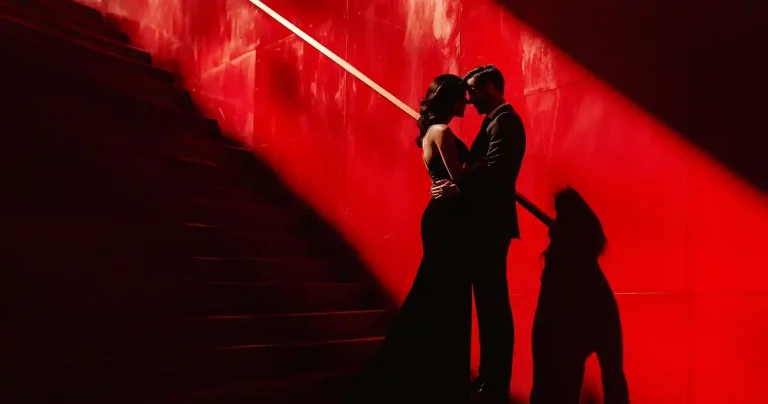Imagine you’re watching a movie, but instead of seeing the action unfold, a character turns to the camera and starts narrating everything. Or maybe you’re inside the character’s head, hearing their every thought. Now, switch it up—what if you were floating above everything, knowing exactly what each character is thinking?
This post also includes insights from bestselling author and writing coach Rachel Aaron and the authors she mentors at The WriteTreat. Their real-world perspective on what makes POV work in actual novels adds human nuance and storytelling depth you won’t find in textbooks.
That, my friend, is the magic of point of view (POV). It’s how a story is told, and it completely changes how the story is experienced.
Let’s break down the different points of view, look at some fun point of view examples, and figure out which one is the best fit for your next story.
What Is Point of View? (And Why Should You Care?)
Point of view is who’s telling the story. Simple, right? Well, not always.
POV controls what the reader knows, how they feel, and even how much they trust the narrator. Choose wisely, and you pull readers deep into your world. Pick the wrong one, and they might feel lost, confused, or worse—bored.
And let’s be real. No one wants that.
First Person: “I Am the Main Character”
Definition: First-person POV means the story is told by a character using “I” or “we.”
Think: Diaries, confessions, and that one friend who always talks about themselves.
Example:
“I walked into the room, heart pounding. I knew I shouldn’t have opened that door, but it was too late now.”
Famous First-Person Examples:
- The Hunger Games by Suzanne Collins (“I volunteer as tribute!” Yep, all told through Katniss’s eyes.)
- The Catcher in the Rye by J.D. Salinger (Holden Caulfield basically invented being a moody teen.)
- To Kill a Mockingbird by Harper Lee (Scout Finch gives us a child’s view of a complicated world.)
Why Use It?
- Super personal—readers get inside your character’s head.
- Great for unreliable narrators (think: someone who bends the truth).
- Helps build deep emotional connections.
Watch Out For:
- Limited perspective—you only know what the narrator knows.
- Can get repetitive (“I walked, I thought, I did this, I did that…” You get the idea.)
Second Person: “You Are the Hero”
Definition: Second-person POV puts the reader directly into the story. It uses “you” as the main character.
Think: Choose-your-own-adventure books, video games, or an intense motivational speech.
Example:
“You step into the dark alley, heart racing. You shouldn’t be here, but you can’t turn back now.”
Famous Second-Person Examples:
- Choose Your Own Adventure books (“You find a mysterious map. Do you follow it? Turn to page 12.”)
- Bright Lights, Big City by Jay McInerney (A whole novel where “you” are the protagonist.)
- How-To Guides (Ever read a recipe? “You mix the flour and sugar together…” Yep, second-person!)
Why Use It?
- Makes readers feel immersed in the story.
- Perfect for interactive storytelling.
- Unique and engaging—great for experimental writing.
Watch Out For:
- Hard to sustain for a whole novel.
- Can feel weird if not done well (“You wake up. You eat toast. You are late for work.” Um, okay?)
That’s the first two points of view! Next, we’ll dive into third person (the most common POV in fiction), plus some cool variations like omniscient vs. limited POV.
Excited? Good! Because choosing the right POV can make or break your story. Stick around for more!
Third Person: “The Storyteller’s Lens”
Now, let’s talk about the big one.
Third-person point of view is the most common in fiction. If first person is “I” and second person is “you,” then third person is all about “he,” “she,” “they,” or even names.
Think of it as a camera following characters around, showing what happens without making the narrator a character in the story.
Third-Person Limited: Sticking to One Head
Definition: The story follows one character at a time, but from an outsider’s perspective. You only know what they know.
Example:
“Jake gripped the sword tightly. He had never faced a dragon before, but backing out wasn’t an option. His heart pounded as the beast roared.”
“If you’re writing third-person limited, don’t suddenly start dropping ‘I’ thoughts. Keep the narrator outside the character’s head.”
—Rachel Aaron, The WriteTreat Zoom sessions
Famous Third-Person Limited Examples:
- Harry Potter by J.K. Rowling (We mostly stick with Harry’s perspective, but it’s told in third person.)
- Percy Jackson by Rick Riordan (Same deal—Percy is the main focus, but the narrator isn’t him.)
- The Hunger Games (Katniss again, but written from outside her head.)
Why Use It?
- Feels personal without being too personal.
- You control how much information the reader gets.
- Keeps some mystery—great for surprises and twists!
Watch Out For:
- Can be limiting (What if the reader needs to know something the character doesn’t?)
- If you jump between characters too fast, it can get confusing.
Third-Person Omniscient: The All-Knowing Narrator
Definition: This is the god mode of storytelling. The narrator isn’t tied to one character—they know everything. Every thought. Every secret. Every plot twist.
Example:
“Jake gripped his sword, unaware that the dragon wasn’t the real threat. Across the valley, Elara watched from the shadows, waiting for her moment to strike.”
Famous Third-Person Omniscient Examples:
- The Lord of the Rings by J.R.R. Tolkien (Tolkien knew everything about everyone.)
- Pride and Prejudice by Jane Austen (Jane Austen wasn’t just in Lizzy’s head—she saw it all.)
- Good Omens by Neil Gaiman & Terry Pratchett (A narrator with personality and total knowledge.)
“The problem with third-person omniscient is if you head-hop too fast, it breaks immersion. Readers need time to adjust.”
—Rachel Aaron, The WriteTreat Zoom sessions
Why Use It?
- You can show multiple characters’ thoughts.
- Great for epic stories with big world-building.
- Helps the reader see the big picture.
Watch Out For:
- Can feel distant—readers might not connect as deeply with one character.
- If not done well, it can lead to head-hopping (switching perspectives too quickly).
Which Point of View Should You Choose?
So, now that we’ve covered all the major points of view, how do you pick the right one?
Here’s a quick cheat sheet:
✅ Want deep emotional connection? → First person.
✅ Want some mystery, but still stick with one character? → Third-person limited.
✅ Want a full, god-like perspective? → Third-person omniscient.
✅ Want to experiment or engage readers directly? → Second person.
The best POV depends on your story. A thriller with big twists? Limited POV might be perfect. A massive fantasy epic? Omniscient might be the way to go.
Just remember: POV is your lens. Pick the one that gives your story the best focus.
Next up, we’ll dive into unusual POVs (yes, they exist!), plus famous books that use POV in mind-blowing ways.
Unusual Points of View: Getting Creative with Perspective
We’ve covered the big ones—first person, second person, and third person (limited & omniscient). But what if you want to shake things up?
Good news! Some authors have taken POV to the next level with unusual, experimental, and downright mind-bending perspectives.
Let’s explore some of the wildest ways to tell a story.
1. First-Person Plural: “We Are the Story”
Yes, we. Not I, not he or she, but we.
In this POV, the narrator speaks as a collective group. This could be a community, a family, or even a group of ghosts (spooky!).
Example:
“We watched as she walked down the street, unaware of what was coming. We knew, but we said nothing.”
Famous First-Person Plural Examples:
- The Virgin Suicides by Jeffrey Eugenides (Told from the perspective of a group of neighborhood boys.)
- And Then We Came to the End by Joshua Ferris (A whole office as the narrator? Yep.)
Why Use It?
- Creates a haunting, mysterious effect.
- Perfect for stories about group identity.
Watch Out For:
- Can feel distant (Who exactly is talking?).
- Hard to sustain for a whole book.
2. Second-Person Present: Living the Story
We already talked about second person (“You enter the room…”). But most second-person stories use past tense. What if you made it present tense?
That means everything happens right now. It feels almost like a dream—or a video game.
Example:
“You are running. The alleyway is dark, but you don’t stop. You hear footsteps behind you. You don’t look back.”
Famous Second-Person Present Examples:
- Half Asleep in Frog Pajamas by Tom Robbins
- Bright Lights, Big City by Jay McInerney
Why Use It?
- Super immersive! Feels like the reader is the character.
- Perfect for fast-paced, immediate storytelling.
Watch Out For:
- Can feel unnatural if not done well.
- Hard to keep it engaging for long.
3. The Unreliable Narrator: Can You Trust Them?
“Eventually, someone’s got to read that or you’ll work on your first book forever.”
—Rachel Aaron, The WriteTreat Zoom sessions
This isn’t a POV itself, but a twist on any POV.
An unreliable narrator tells the story, but they’re not telling the whole truth. Maybe they’re lying. Maybe they’re biased. Maybe they just don’t get it.
Example:
“I swear, I had nothing to do with the missing diamond. I mean, sure, I was in the room. And, okay, I did touch the safe. But it wasn’t me!”
Famous Unreliable Narrator Examples:
- Gone Girl by Gillian Flynn (You think you know the truth… until you don’t.)
- Fight Club by Chuck Palahniuk (Narrator with a secret? Check.)
- The Catcher in the Rye by J.D. Salinger (Holden Caulfield: the king of unreliable storytelling.)
Why Use It?
- Keeps readers guessing!
- Great for mystery, suspense, and plot twists.
Watch Out For:
- Can frustrate readers if overdone (Wait… was anything real?!).
4. Second-Person Horror: The Creepiest POV?
Okay, imagine this: You open a book, and it starts talking to you. It knows what you’re thinking. It sees you.
Some horror writers use second person to make the reader feel personally trapped in the story.
Example:
“You hear a noise behind you. You turn, but there’s nothing there. Or so you think.”
Famous Examples:
- House of Leaves by Mark Z. Danielewski (Mind-bending, reality-warping horror.)
- Night Film by Marisha Pessl (A thriller that makes you feel like you’re part of it.)
Why Use It?
- Super unsettling.
- Feels personal, like the story is happening to you.
Watch Out For:
- Too creepy? (Or maybe just creepy enough?)
So… Which POV Should You Experiment With?
If you want a classic storytelling experience, stick with first or third person.
But if you’re feeling adventurous? Try second person, first-person plural, or an unreliable narrator.
“If you try to have a reactive character take the initiative, you’re going to have to pry them into the story with a crowbar.”
—Rachel Aaron, The WriteTreat Zoom sessions
Next up: We wrap things up with famous POV mistakes, plus final tips on mastering perspective!
POV Mistakes to Avoid (And How to Fix Them!)
You’ve got the POV basics down. You know your first-person from your third-person omniscient. Maybe you’re even tempted to write a spooky second-person horror novel (do it!).
But before you go wild, let’s talk about common POV mistakes—and how to dodge them like Neo in The Matrix.
1. Head-Hopping: The Reader’s Worst Nightmare
Ever been reading a book where, suddenly, the POV switches mid-paragraph?
One second, you’re inside Sarah’s head. The next, you’re in John’s. And before you can blink, you’re in the dog’s thoughts. (Rex just wants snacks, okay?)
This is called head-hopping, and it’s confusing. Readers need time to adjust when POV shifts. Jumping around too quickly makes the story feel jumbled.
How to Fix It:
- Stick to one character per scene (or at least one per chapter).
- If you must switch, make it clear with a scene break.
✅ Wrong:
“Sarah sighed. She had never felt lonelier. John, on the other hand, was thrilled to be out of the house.” (Wait, what? Who am I following?)
✅ Right:
“Sarah sighed. She had never felt lonelier.
(Break or new chapter)
John leaned back in his chair, finally free of the awkward dinner party.”
See the difference? Smooth, clear, and no brain whiplash.
2. Choosing the Wrong POV for Your Story
Not all POVs fit every story.
Imagine Harry Potter in second person:
“You receive a letter from Hogwarts. You don’t believe it at first. But soon, you’re on a train to wizard school.”
Nope. Doesn’t hit the same.
How to Fix It:
- First person = Deep emotional connection (good for personal, introspective stories).
- Third-person limited = Balance of depth and flexibility (great for mysteries, fantasy, thrillers).
- Third-person omniscient = Wide scope (perfect for epics, multiple perspectives).
- Second person = Use sparingly (unless you’re writing a Choose Your Own Adventure book).
Pick the POV that fits your story’s vibe.
3. Writing in a POV You Can’t Maintain
Ever read a book that starts in third person, but suddenly slips into first-person thoughts?
It’s like watching a movie, then—bam!—one of the characters breaks the fourth wall. (Deadpool can get away with it. You? Maybe not.)
How to Fix It:
- If you’re writing third-person limited, don’t suddenly start dropping “I” thoughts. Keep the narrator outside the character’s head.
- If you’re writing first-person, make sure every description makes sense from that character’s POV. (They can’t describe their own facial expression unless they’re looking in a mirror!).
Stay consistent. If your POV starts one way, commit.
4. Not Using POV to Enhance Your Story
POV isn’t just a tool—it’s a weapon. It’s what makes your story feel right.
A murder mystery? Third-person limited keeps the clues hidden.
A deeply personal coming-of-age story? First-person makes us feel every heartbreak.
A twisted thriller? An unreliable narrator can blow readers’ minds.
Use POV strategically. It’s not just about who’s telling the story—it’s about how the reader experiences it.
Final POV Takeaways
POV is one of the most powerful choices you’ll make as a writer.
To sum up:
- First person = Deep, personal, emotional.
- Second person = Bold, immersive, experimental.
- Third-person limited = Focused, controlled, great for suspense.
- Third-person omniscient = Expansive, big-picture storytelling.
- Unusual POVs = If you’re feeling brave, go for it!
“Plot exists to put characters in cool situations. That’s its purpose. No one remembers plot—they remember people doing things.”
—Rachel Aaron, The WriteTreat Zoom sessions
And above all: Stay consistent, pick the right POV for your story, and use it to make your writing stronger.Now, go forth and write with confidence. 🚀








